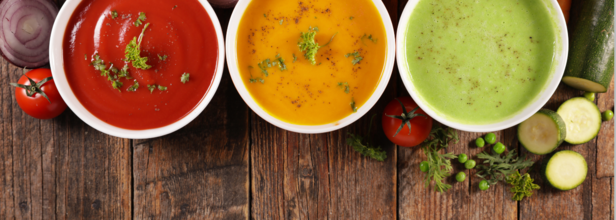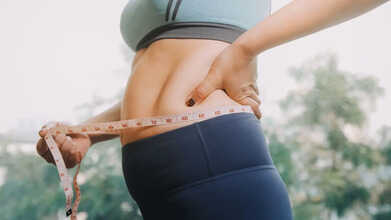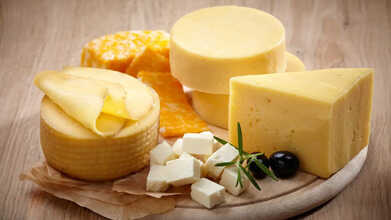- Health Conditions A-Z
- Health & Wellness
- Nutrition
- Fitness
- Health News
- Ayurveda
- Videos
- Medicine A-Z
- Parenting
Planning To Start A Liquid Diet? What You Can Eat And What To Avoid

Image Credit: Canva
A liquid diet can be a very viable approach towards managing specific health conditions, as well as a quick weight loss remedy. Whether prescribed by a doctor for medical reasons or adopted as a means of detoxification or weight management, the liquid diet requires careful planning and understanding. It involves consuming only liquids or foods that turn liquid at room temperature. However, embarking on this dietary journey involves knowing which foods are included, the potential risks, and the guidelines to follow.
Here is everything you must know to begin on a liquid diet.
What is Liquid Diet?
A liquid diet, in a nutshell, is a diet that limits food intake of solid to be taken in a liquid form, food that can liquefy at room temperature. These include juice, smoothies, and even broths, or gelatin and ice pops. Liquid diets are commonly done in the hospital for those who cannot take in a normal diet because of health reasons, such as after surgery, due to illness, or digestive issues.
There are mainly two types: clear liquid diet and full liquid diet. Although they have both found wide usage in a medical field, individuals are known to keep the diet of this nature just to detox or shed off the body weight. As such, details of what can be eaten and what is allowed will all be dependent upon what version is one using as well as one's reason behind going for it.
Types of Liquid Diets
1. Clear Liquid Diet
A clear liquid diet is the most restrictive type of liquid diet. Stanford University Medical Center defines clear liquids as liquid that is translucent and usually devoid of any particles of solid food. Some of the most common foods in a clear liquid diet include clear broths, tea, cranberry juice, Jell-O, and popsicles. This diet is usually prescribed before undergoing any medical procedure or surgery as it gives the digestive system time to rest. The point of an all-liquid diet is that it offers nutrition in limited amounts and thus should only be used in short duration, such as 3 to 5 days at most and always under strict medical supervision.
2. Full Liquid Diet
A full liquid diet is not as restricted and provides a wide variety. This diet contains all the food components of the clear liquid diet and adds thicker liquids, including cream-based soups, milkshakes, pudding, and pulp-containing juices. Full liquid diets are commonly given to patients immediately after surgery or other medical interventions to transition patients from a clear liquid diet toward solid foods once they have improved.
This diet can be a more balanced source of nutrition because it might contain drinks such as Ensure or Boost, which contain necessary nutrients-protein and calories.
Also Read: This Vegetable Juice Is One Of The Most Hydrating Drinks You Can Have
What Can Be Eaten on a Liquid Diet
While on a liquid diet, food choice is left mostly to the kind of liquid diet that a patient is undergoing. The foods below are allowed in each kind:
- Clear broths or consommes
- Tea, black or green, without milk or cream
- Cranberry juice or apple juice, pulp-free
- Popsicles and gelatin
- Clear sports drinks, without artificial colors or sweeteners
This diet is best for pre-surgery preparation, post-surgery recovery, or detoxification before diagnostic tests. It is essential to note that a clear liquid diet is not meant to be a long-term source of nutrition since it does not contain high levels of vitamins, minerals, or proteins.
All liquids as listed above clear diet
- Soups pureed or strained (creamed tomato, vegetable soup, etc.)
- Milkshakes and smoothies
- Pudding, custard, ice cream, with no lumps
- Nutritional drinks like Ensure or Boost
- Fruit juices with pulp is allowed
This diet is very flexible and allows for a much more nutritional diet, which will be needed when the patient has to consume many calories, proteins, and all the essential vitamins while recovering from illness or surgery.
Managing Meals on a Liquid Diet
Breakfast
You might start the day on a liquid diet, such as a glass of fruit juice or a nutritional drink. These are helpful for adding calories and protein to your intake. You can have tea or coffee without cream or milk. You might be able to have cooked cereal, such as oatmeal or cream of wheat, thinned with extra milk on a full liquid diet.
Lunch and Dinner
In a clear liquid diet, foods are mainly the clear broth or consomme. Other allowed foods in the diet include Jell-O, clear sports drinks, and plain popsicles. In a full liquid diet, lunch and dinner may consist of pureed soups or creamed and strained soups like cream of mushroom or chicken. Protein powder or skim milk powder can be added to soups to raise protein levels.
Snacks and Desserts
Liquid diets are commonly supplemented with nutritious snacks and desserts. For instance, milkshakes, pudding, ice cream, or fruit juice bars are all filling, yet nutrient-providing foods. If you are on a full liquid diet, custard-style yogurt or creamy smoothies with added protein powder or honey can keep you full and fulfill your caloric needs.
How Liquid Diets Can Impact Weight Loss?
Although liquid diets are prescribed for medical reasons, some people follow them to lose weight. Liquid diets without medical supervision may include drastically reduced calorie intake. Most people use juice cleanses or all-liquid detox diets, which include a mix of fruit and vegetable juices, smoothies, and water throughout the day.
A study published in Obesity Surgery (2018) reported that patients who were on a very low-calorie liquid diet before bariatric surgery lost a lot of weight, about 8-10 pounds within one to two weeks. However, using liquid diets for weight loss purposes may not be sustainable in the long term and can be challenging to maintain. Moreover, the weight loss may not be significant enough to justify using this approach long-term.
For those looking to lose weight, a more balanced approach is usually recommended, such as the Mediterranean diet or other well-balanced meal plans that are more sustainable and provide adequate nutrition.
Do You Need a Liquid Diet?
If your doctor prescribes a liquid diet, it’s typically safe to follow, but it's essential to consult your healthcare provider to discuss any changes or concerns during your diet. A liquid diet can be an effective tool for pre-surgical preparation or recovery, but it should be followed carefully and under the guidance of a professional.
For those thinking about a liquid diet to lose weight, it's important to keep in mind that liquid diets are not a long-term solution. They may help you achieve results quickly, but sustainable weight loss requires a balanced, nutritious eating plan that you can stick with for the long haul. A dietitian or nutritionist consultation before beginning a liquid diet can help ensure you're making a healthy decision about your health.
Starting a liquid diet, whether for medical reasons or weight loss, requires careful planning and guidance. Understanding the types of liquid diets and their potential risks is crucial to ensuring you maintain optimal health while following the plan. Always consult your doctor before beginning any liquid diet, and remember that a balanced, long-term approach to nutrition is key to sustained health and wellness.
The Effects Of Under-Eating. National Centre for Eating Disorders.
Defining the Optimal Dietary Approach for Safe, Effective and Sustainable Weight Loss in Overweight and Obese Adults. Healthcare (Basel). 2018
Effectiveness, Compliance, and Acceptability of Preoperative Weight Loss with a Liquid Very Low-Calorie Diet Before Bariatric Surgery in Real Practice. OBES SURG. 2019
What Is The Best Time To Eat Dinner?

Credits: Canva
Eating is something we do every day, and its connection to our weight is undeniable. Most of us concentrate on what we eat, and rightly so, because the nutritional value and calorie content of food directly impact our weight. Yet, an increasingly important factor in weight management is when we eat. Nutritionist Pooja Makhija explains the science behind having early dinners, particularly in the evening, and how this aligns with the body clock to support overall weight management.
In an Instagram video, she writes in the caption, “You don't start digesting worse at night because of the food… you digest worse because melatonin has already risen,” adding, “Melatonin climbs 2–3 hours before your bedtime, dropping your insulin sensitivity by up to 50% and switching fat cells into storage mode. So the same meal hits very differently at 7 pm vs 10 pm.”
What Is Melatonin?
Melatonin is a hormone made by the pineal gland in the brain that helps control the body’s sleep-wake cycle. Its levels usually rise in the evening, peak during the night, and fall in the early morning. Many doctors even recommend melatonin supplements to help regulate sleep patterns, though they can sometimes cause side effects, so consulting a physician is advised, as per Healthline.
How Does Melatonin Affect Your Fat Storage In Body?
In her video, Pooja grabs attention by asking, “We all know that melatonin makes you sleepy. But what if I told you that melatonin wakes up your fat cells and makes them store more? Hadn't heard of that?”
She continues, “Melatonin isn’t just your sleep hormone. It’s your body’s night mode switch. As it rises in the evening, your metabolism slows down. Insulin sensitivity drops 25 to 50 percent, glucose clearance slows, and your fat cells switch from burning energy to storing it.” Referring to a study published in the *Clinical Endocrinology and Metabolism* journal, she adds, “People who ate dinner when their melatonin was high had a 34 percent higher glucose spike. Same people, same meal, same calories—just bad timing.”
What Is Front Loading Calories?
Front-loading calories is a way of eating where most of your daily calories are consumed earlier in the day, with a big breakfast and hearty lunch and a lighter dinner in the evening. This approach matches your meals with your body’s natural circadian rhythms, improving metabolism, insulin response, and appetite control. It helps with weight management and energy levels by taking advantage of the morning metabolism, reducing late-night cravings, and supporting better sleep.
What Is The Correct Time To Have Dinner To Prevent Fat Storage And Weight Gain?
Pooja Makhija says the most effective method to prevent melatonin from triggering fat storage is to eat early dinners and front-load calories during the day.
“So when most of your calories land late at night, it’s at a time when your biology is saying, ‘I’m done for the day; I’m not burning more.’ In contrast, front-loading calories with a big breakfast, solid lunch, and small dinner means you’re eating when melatonin is low. Your insulin is sharp, mitochondria are active, and your body is in daytime burning mode,” she explains.
She concludes with a reminder: “Your fat cells have melatonin receptors, and they behave differently depending on the time of day. Front-loading isn’t a hack—it’s circadian biology. Melatonin guides your metabolism. So eat in tune with your body clock, not against it, and notice the difference.”
According to Healthline, the ideal dinner time for better melatonin regulation and metabolism is 2–3 hours before bedtime—before your body naturally begins releasing melatonin—to avoid insulin spikes and fat storage.
Afraid You Will Gain Weight With Christmas Feast? Here's What You Can Do

Credits: iStock
Christmas is meant to be joyful, but the fear of gaining weight often sneaks in between helpings of roast potatoes and dessert. There is a reason this worry feels real. Nearly half of the weight many people gain in a year tends to show up during holiday periods, and once gained, it often sticks around longer than expected. The good news is that enjoying festive food does not have to mean starting the new year with regret. Smart choices, balanced plates, and mindful eating can make all the difference.
Build your plate around plant-forward foods
Festive spreads are often richer than everyday meals, which is why vegetables play a key role in keeping things balanced. Christmas classics like Brussels sprouts, red cabbage, carrots, parsnips, onions, and even potatoes offer more than color and crunch.
Cruciferous vegetables such as Brussels sprouts and red cabbage support the body’s natural detox systems and provide compounds linked to healthy ageing.
Roasted root vegetables supply complex fibers that feed good gut bacteria, helping digestion stay on track despite heavier meals. Onions support natural cleansing processes, while cooked and cooled potatoes contain resistant starch that behaves like fiber and helps keep blood sugar steady. This also makes leftovers a surprisingly good option.
Adding grains and healthy fats further improves satiety. Quinoa provides complex carbohydrates along with complete protein, while avocado contributes heart friendly fats that help you feel full longer. Pomegranate seeds add antioxidants and support gut and heart health, making them a festive ingredient worth sprinkling generously.
Pair plants with protein for better balance
A common reason for holiday overeating is a lack of protein on the plate. Protein helps regulate appetite and keeps energy levels stable. Plant based mains such as mushroom wellingtons, nut roasts, or lentil loaves work well for this reason. Mushrooms offer antioxidants and immune supporting nutrients, while lentils provide protein, iron, and fiber without excess fat. Chestnuts stand out among nuts because they act more like a starch, making them filling but lighter than many other nut based foods.
Even for non vegetarians, these dishes can sit comfortably alongside traditional mains, adding variety and balance without sacrificing flavor.
Mindful eating matters as much as food choices
What and how you eat both matter during the holidays. Slowing down helps the body register fullness before overeating sets in. Taking time to notice the aroma, texture, and taste of food improves satisfaction, often with smaller portions. Putting cutlery down between bites and staying present at the table can naturally reduce mindless eating.
Hydration is another simple but powerful tool. Alcoholic drinks are calorie dense and dehydrating, which can increase appetite. Alternating festive drinks with water or fruit based punches helps manage intake while still allowing you to join the celebration.
Choose desserts that satisfy without excess
Dessert does not need to be skipped to stay on track. Lighter versions can be just as comforting. Fruit based options like baked apples, berry crumbles with oats and nuts, or spiced poached pears offer natural sweetness and fiber. Greek yogurt based desserts provide protein and probiotics that support digestion and help prevent overindulgence.
Dark chocolate with a high cocoa content can also fit in. A small portion enjoyed slowly with fruit delivers antioxidants and satisfies cravings without going overboard. Nuts and dates make rich, festive treats too, but portion awareness matters since they are calorie dense.
Focus on joy, not guilt
Christmas food is about connection, tradition, and pleasure. Guilt free enjoyment actually supports digestion and overall wellbeing. When meals are built around vegetables, balanced with protein, and eaten mindfully, the festive season can feel indulgent without tipping into excess. The goal is not perfection, but balance. Nourish the body, enjoy the moment, and let Christmas be both festive and kind to your health.
Can Eating Cheese Reduce Dementia Risk? Scientists Find A Surprising Link

Credits: Canva
Cheese And Dementia Risk: One of the world’s most loved foods may offer an unexpected benefit for brain health. A long-term study has shown that regularly eating high-fat cheese is linked to a lower chance of developing dementia.
The findings come from research published December 17 in Neurology, the medical journal of the American Academy of Neurology. Scientists in Sweden examined dietary information from roughly 27,600 participants in the Malmö Diet and Cancer study, who were followed for an average of 25 years, and discovered a surprising connection between cheese consumption and dementia risk.
Cheese And Dementia Risk: Eating Cheese Linked To Lower Dementia Risk
High-fat cheeses and cream may help reduce the risk of dementia, according to a new study. Published in Neurology, the research found that individuals who included two servings of high-fat cheese in their daily diet were less likely to develop dementia. Participants who ate 50 grams or more of high-fat cheese per day had a 13% lower risk compared to those who consumed less than 15 grams, the study reported. Similarly, people who included more high-fat cream in their diet had a 16% lower risk than those who had none, as per USA Today.
While the study shows an association between high-fat cheese and cream and reduced dementia risk, it does not prove that eating these foods directly prevents the condition. “This does not prove that cheese prevents dementia, but it does challenge the idea that all high-fat dairy is harmful for the brain,” said study co-author Emily Sonestedt, a nutrition researcher at Lund University in Sweden, where the Malmö Diet and Cancer study is based, in an interview with USA TODAY. “For most people, it means that enjoying cheese in reasonable amounts, as part of a balanced diet, does not appear harmful and may even have some benefit.”
Cheese And Dementia Risk: Which High-Fat Cheeses Were Linked To Lower Dementia Risk In The Study?
The Swedish research specifically linked daily intake of high-fat cheeses—Brie, Gouda, and Cheddar—to a lower risk of developing dementia. Participants who consumed at least 50 grams of these cheeses each day experienced a 13% drop in dementia risk compared to those who ate smaller amounts.
The study also noted reduced risks of Alzheimer’s disease in certain genetic groups, though the researchers caution this does not prove a cause-and-effect relationship. Rather, it challenges the assumption that all high-fat dairy negatively affects brain health. Experts highlight that including these cheeses in moderation, as part of a balanced diet, could be beneficial.
Importantly, how cheese fits into a person’s overall diet may influence dementia risk. Sonestedt pointed out that U.S. dietary habits differ from Sweden’s, where cheese is often eaten uncooked, while in the U.S., it’s frequently heated or paired with meat. “A person’s overall dietary context matters,” she said. “Cheese eaten on a hamburger or with processed meat is very different from cheese eaten with healthier foods. We are not suggesting people switch to high-fat cheese as a strategy.”
Cheese could still be a healthier alternative in some cases. “Choosing cheese instead of a hotdog may be a step in the right direction,” said Yeh, “but the broader body of evidence suggests there are even better options for supporting cognitive health.”
The findings arrive as Health and Human Services Secretary Robert F. Kennedy Jr.’s Make America Healthy Again commission pushes to reintroduce whole milk in schools, despite ongoing questions about the health impact of saturated fats in milk.
© 2024 Bennett, Coleman & Company Limited

